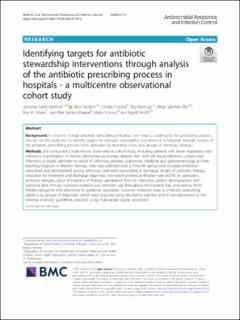Identifying targets for antibiotic stewardship interventions through analysis of the antibiotic prescribing process in hospitals - a multicentre observational cohort study
Wathne, Jannicke Slettli; Skodvin, Brita; Charani, Esmita; Harthug, Stig; Blix, Hege Salvesen; Nilsen, Roy Miodini; Kleppe, Lars Kåre Selland; Vukovic, Marta; Smith, Ingrid
Journal article, Peer reviewed
Published version

Åpne
Permanent lenke
https://hdl.handle.net/11250/2727840Utgivelsesdato
2020Metadata
Vis full innførselSamlinger
- Department of Clinical Science [2318]
- Registrations from Cristin [9791]
Originalversjon
Antimicrobial Resistance and Infection Control. 2020, 9, 114. 10.1186/s13756-020-00749-ySammendrag
Background:
In order to change antibiotic prescribing behaviour, we need to understand the prescribing process. The aim of this study was to identify targets for antibiotic stewardship interventions in hospitals through analysis of the antibiotic prescribing process from admission to discharge across five groups of infectious diseases.
Methods:
We conducted a multi-centre, observational cohort study, including patients with lower respiratory tract infections, exacerbation of chronic obstructive pulmonary disease, skin- and soft tissue infections, urinary tract infections or sepsis, admitted to wards of infectious diseases, pulmonary medicine and gastroenterology at three teaching hospitals in Western Norway. Data was collected over a 5-month period and included antibiotics prescribed and administered during admission, antibiotics prescribed at discharge, length of antibiotic therapy, indication for treatment and discharge diagnoses, estimated glomerular filtration rate (eGFR) on admission, antibiotic allergies, place of initiation of therapy, admittance from an institution, patient demographics and outcome data. Primary outcome measure was antibiotic use throughout the hospital stay, analysed by WHO AWaRe-categories and adherence to guideline. Secondary outcome measures were a) antibiotic prescribing patterns by groups of diagnoses, which were analysed using descriptive statistics and b) non-adherence to the national antibiotic guidelines, analysed using multivariate logistic regression.
Results:
Through analysis of 1235 patient admissions, we identified five key targets for antibiotic stewardship interventions in our population of hospital inpatients; 1) adherence to guideline on initiation of treatment, as this increases the use of WHO Access-group antibiotics, 2) antibiotic prescribing in the emergency room (ER), as 83.6% of antibiotic therapy was initiated there, 3) understanding prescribing for patients admitted from other institutions, as this was significantly associated with non-adherence to guideline (OR = 1.44 95% CI 1.04, 2.00), 4) understanding cultural and contextual drives of antibiotic prescribing, as non-adherent prescribing differed significantly between the sites of initiation of therapy (between hospitals and ER versus ward) and 5) length of therapy, as days of antibiotic therapy was similar across a wide range of diagnoses and with prolonged therapy after discharge.
Conclusions:
Analysing the process of antibiotic prescribing in hospitals with patient-level data identified important targets for antibiotic stewardship interventions in hospitals.
